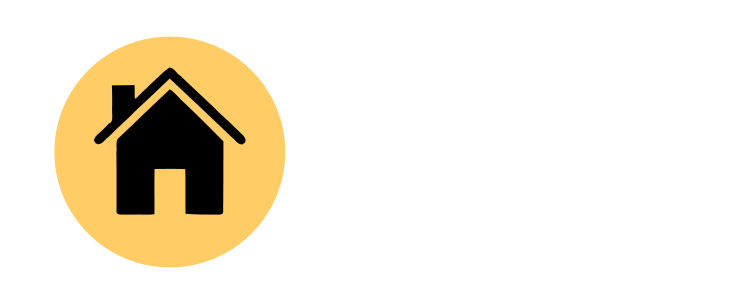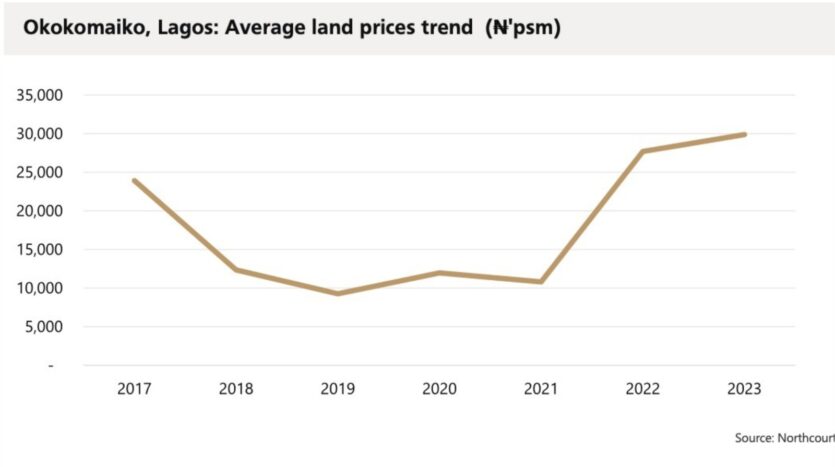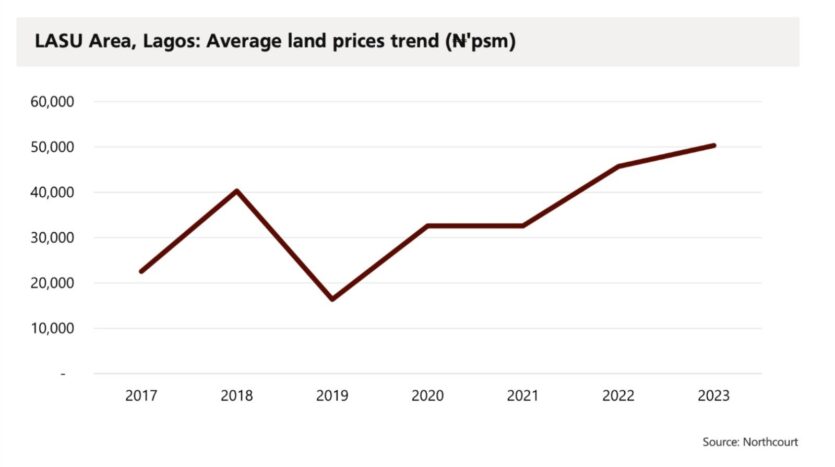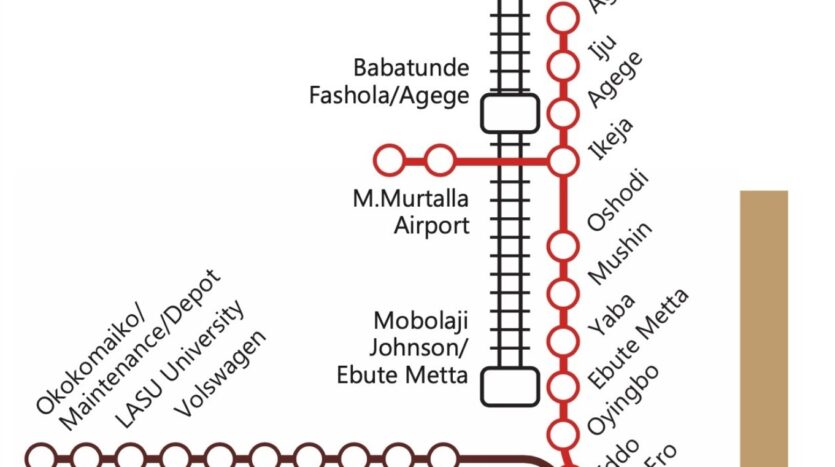Assessing the short, medium and long term impacts of the Lagos Blue Rail line on the real estate market
This study describes a future in which the Blue Rail Line would connect the expansive city of Lagos, taking commerce and opportunity to new heights, taking people from the bustling marketplaces of Lagos Island to the Mainland and other states as Ogun, Oyo, Edo, Osun, Ondo and by extension, the rest of the country with ease and comfort. However, our research outlined some obstacles. The high cost of construction, the difficulties of navigating the urban fabric of the city, the difficulty of obtaining government funding, and the potential for slum development. Despite these obstacles, the Lagos Blue Rail Line is one of progress and perseverance that will have short, medium, and long-term consequences.
Short Term Impacts
1. Adoption and increased demand for real estate
The adoption of the Lagos Blue Line by a large proportion of the public will likely improve the demand for real estate assets along the Blue Line corridor. White-collar workers would likely benefit much from this transformation. They would be able to get to work much more efficiently due to the accessibility of public transit. Traders and business owners will be able to access more customers and clients with enhanced connectivity. The Blue Line would generate new growth prospects for businesses, allowing them to increase their geographic reach. The implementation of the Blue Line would have a favourable effect on the local economy by introducing new economic opportunities and improving the standard of living by alleviating traffic congestion.
2. Pressure on existing infrastructure
The Lagos Blue Line will act as a pull factor, attracting the occupier, developer, and investor class. This is in part due to the efficiency and comfort of commuting by train, as opposed to other means of transportation. Existing infrastructure such as roadways, drainage systems, and water supply systems are projected to experience additional strain in the near future, as the demand for housing and business spaces close to the rail line grows. It is expected that the Lagos State Government and urban planners evaluate the long-term effects of the Blue Line and make the required preparations to support the anticipated migration into these nodes. It is necessary to recognise the potential difficulties that may arise and to address them proactively. This will ensure that communities near the rail benefit from the railway’s convenience and comfort without jeopardising their overall quality of life
3. Increase in speculator activity
Speculative property acquisitions are on the rise and this tendency will only increase. This is a result of the successful implementation of the project, which has sparked some trust in the government’s ability to fulfil its commitments.
Mid Term Impacts
1. Development activity
Along the Blue Line corridor, we anticipate a rise in demand and a rise in development activity in the mid-term. The emphasis would be on multitenant buildings in the residential submarket and mixed-use properties combining retail and office space. Investors are eager to capitalise on the area’s potential by developing residential communities that serve the demands of a diverse population. This is advantageous not just to the occupiers, but also to the business community, which is afforded opportunities for growth and expansion.
This expansion comes at a price. With the growth in development activity, there will be a rise in the termination of some residential leases in favour of commercial ones and departure of tenants to make room for the renovation and reconstruction of older structures. This will cause some inconvenience for the affected tenants, but it is crucial for growth.
The emphasis on multi-tenanted developments and mixed-use assets is indicative of the area’s potential, and the increased termination of leases and the departure of tenants are required to ensure that the neighbourhood remains vibrant. Investors ready to take advantage of the opportunities given by this expansion have a promising future.
2. Upward price movements
The increased demand for real estate in the near future around the nodes through which the Blue Rail Line traverses would contribute to a rise in property prices. It is vital to highlight that this increase would be disproportionally spread across locations affected by the project.

Developments near the Lagos Blue Line stations would experience higher price increases than those in the interior areas. Proximity to, and easy access to public transportation influences real estate pricing –per Bid-Rent Theory proposed by American economist William Alonso in 1964. This theory suggests that the value of land is determined by its highest and best use and that this use is affected by the cost of transportation.
Due to their increased accessibility, properties near train stations may have higher bid rents and thus, greater value, as they can be used for more intense development. Users are prepared to pay a premium for the convenience of being close to public transportation, and this is reflected in the more rapid rate of price appreciation in these locations. In the mid-term, residential and rental prices will likely experience the highest increase, followed closely by retail and office space. This is due to the increased demand for residential and commercial real estate near the Lagos Blue Line stations. Land values would increase based on their proximity to the Blue Line stations.
3. Potential uneven development
Certain regions would experience faster growth than others, due to occupier preferences and the quality of existing infrastructure and services. Some nodes already have a robust economy and well-developed transportation infrastructure, making them more attractive to businesses and residents. Consequently, it would not be unusual for some nodes to have more activity than others. These nodes are frequently the initial economic development generators. These discrepancies in development may be minimised over time as other regions begin to catch up and the advantages of growth and development become more widely distributed.
4. A preference for long-term leases
The speculative appeal of locations near rail routes can significantly influence the dynamics of property ownership and investment decisions. Property owners may choose long-term leases to safeguard their interests, maximise their rents, and keep control over the property’s usage and development. This would emphasise careful planning when signing leases.
5. Increased Public, Private Partnerships in addressing the problem of informal housing
The problem of informal housing has plagued Lagos for decades. In some nodes, the surge in development activities as a result of the Lagos Blue Line will increase the number of slum developments. The central authorities will need to provide the necessary infrastructure and support to ensure the success of housing developments executed by the private sector. Civil society groups will need to educate and equip communities on taking ownership of the consequent housing schemes and assure their long-term sustainability. This multi-stakeholder approach involving government, civic society, and the private sector is required to guarantee the success of housing initiatives.
initial economic development generators. These discrepancies in development may be minimised over time as other regions begin to catch up and the advantages of growth and development become more widely distributed.
6. Urban renewal
Rehabilitating and renovating historic buildings to improve the appeal of existing uses is a crucial component of this process since it can have far-reaching effects on the growth and development of Lagos. Urban renewal projects can rejuvenate neglected neighbourhoods. The Lagos Blue Line will possibly accelerate this, enhancing the occupier’s quality of life, improving property values, and attracting new industries. Urban redevelopment should be approached with caution, thoroughly evaluating both positive and negative repercussions. The restoration of old buildings will likely provide much-needed housing and commercial space, but it may also lead to the displacement of low-income residents and SMEs – asides from the loss of heritage sites.
Since residential property prices have a stronger positive correlation with proximity to rail stations than commercial property prices, residential property sales prices will increase rapidly. This can be the basis for new pricing for commercial property owners. Residential properties close to the Blue Line Rail stations will be highly susceptible to conversion to commercial use, as they command higher rents and existing infrastructure in impacted areas will be strained. Real estate car parking
Long term Impacts
1. Growth in rental and capital values
Along the Blue Rail line, we anticipate a sustained increase in transaction volumes within the real estate market, which will likely contribute to rental and capital value growth.
2. Increased number of gated communities and property uses:
Gated communities and multi-tenanted developments have been on the rise in response to rising concerns around security and inclusive living. Despite the likelihood that the Blue Line project would result in an increase in gated communities and multi-tenanted complexes, it is essential to assess the advantages and disadvantages. These communities will rise as a response to the increased demand for residential real estate along the rail line. The Blue Rail Line will result in the development of education, religious, hospitality, and retail use in low-density areas. Furthermore, areas close to the rail stations are expected to see a surge in retail and hospitality use. The expansion of the rail line, specifically with the addition of a cargo segment, will drive demand for warehousing real estate and an increase in the supply of retail assets that cater to pseudo-office demand.
3. Infrastructure development
The rise in capital expenditure for infrastructure projects as a result of the Blue Line will result in the development of key infrastructure such as roads, drainage systems, and electricity supply. It is essential to recognise the importance of extracting the most possible value for the Lagos real estate market from the Blue Line, which is contingent on careful preparation and implementation. Road networks should complement the rail network, with the integration of public transport support services and the provision of occupier-friendly infrastructure. This project will act as a benchmark and may serve as a model for other states across the nation, resulting in accelerated national infrastructure development. Some states may plan to connect directly with the Lagos rail network.
4. Economic impact
The Blue Line project is anticipated to have substantial economic effects on the state of Lagos and its residents. Asides from its potential to increase economic activity by decreasing the cost and amount of time required for businesses to carry goods it will lead to the generation of jobs – personnel who will manage the Blue Line’s system and maintain the infrastructure. The implementation of the Lagos Blue Rail Line is expected to result in the creation of a significant number of jobs both directly, through the operation of the rail line, and indirectly, as a result of the positive impact it will have on the local business environment. It is worth noting that the transport sector has consistently been a major contributor to the revenue of the Lagos state government, and the Blue Line project is poised to further enhance this revenue stream.
Download the full report here
Contacts
Real Estate Research & Advisory
Ayo Ibaru
ayo.ibaru@northcourtrealestate.com
+234 818 518 6975
Northcourt is a real estate investment solutions company that adopts a research-based approach to developing and managing property as well as providing real estate advisory services in West Africa. put this at the bottom of the first page









